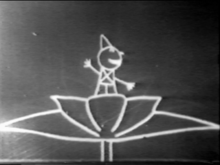- Inbetweening
-
Inbetweening or tweening is the process of generating intermediate frames between two images to give the appearance that the first image evolves smoothly into the second image. Inbetweens are the drawings between the key frames which help to create the illusion of motion. Inbetweening is a key process in all types of animation, including computer animation.
Contents
In digital animation
 This animated GIF demonstrates the effects of Adobe Flash shape, motion and color tweening.
This animated GIF demonstrates the effects of Adobe Flash shape, motion and color tweening.
When animating in a digital context, especially with Adobe Flash, the shortened term tweening is commonly used. Sophisticated animation software enables one to identify specific objects in an image and define how they should move and change during the tweening process. Software may be used to manually render or adjust transitional frames by hand or may be used to automatically render transitional frames using interpolation of graphic parameters. In the context of Adobe Flash, inbetweening using automatic interpolation is called tweening, and the resulting sequence of frames is called a tween.
"Ease-in" and "ease-out" in digital animation typically refer to a mechanism for defining the physics of the transition between two animation states, i.e., the linearity of a tween.[1]
The use of computers for inbetweening was pioneered by Nestor Burtnyk and Marceli Wein at the National Research Council of Canada. They received a Technical Achievement Academy Award in 1997, for "pioneering work in the development of software techniques for computer assisted key framing for character animation".[2]
In traditional animation
Traditional inbetweening involves the use of light tables to draw a set of pencil-on-paper pictures.
In the inbetweening workflow of traditional hand-drawn animation, the senior or key artist would draw the keyframes which define the movement, then, after testing and approval of the rough animation, would hand over the scene to his or her assistant. The assistant does the clean-up and the necessary inbetweens, or, in large studios, only some breakdowns which define the movement in more detail, then handing down the scene to his assistant, the inbetweener who does the rest.
Frame frequency
Typically, an animator does not draw inbetweens for all 24 frames required for one second of film. Only very fast movements require animation "on ones", as it is called. Most movements can be done with 12 drawings per second, which is called animating "on twos". Too few inbetweens distort the illusion of movement, such as in cheap TV animation series where there can be as few as 4 drawings for a second of film. Computer generated animation is usually animated on ones. The decision about the number of inbetweens is also an artistic one, as certain styles of animation require a not-so-smooth fashion of movement. Animation "on twos" dates to the dawn of animation – Fantasmagorie (1908), widely considered the first fully animated movie, was animated on twos.
See also
- Flicker fusion threshold
- Morphing
- Onion skinning
- Cacani
- Motion blur
- Synfig a Free and Open Source Software (FOSS) tweener
References
- ^ Set of graphs showing 30 different easing curves
- ^ IMDb: Academy Awards, USA: 1997. Retrieved on August 9, 2006.
External links
Animation topics By country China · India · Japan · Korea · Philippines · United States
Azerbaijan · Canada · China · France · Iran · Japan · Russia · United Kingdom · United States
Industry Animator (List of animators) · Animation director · Animation studios · biologist simulateurs · Animation film festivals (international / regional)
Works Feature-length films · Short films · Television series (1900s) (2000s) · Films based on animated cartoons · Computer-animated films · Stop-motion films
Techniques Clay (strata-cut) · Cutout (silhouette) · Graphic · Model (go motion) · Object · Pixilation · Puppetoon
Flash · PowerPoint · SVG
Other methodsDrawn-on-film · Flip book · Inbetweening · Paint-on-glass · Pinscreen · Pixel art · Pose to pose · Sand
Related topics Cartoon series · Cartoon physics · Animated cartoon · Character animation · Independent animation · Adult animation · List of animated shorts available on DVD
Categories:- Computer animation
- Computer graphic techniques
- Animation techniques
Wikimedia Foundation. 2010.

